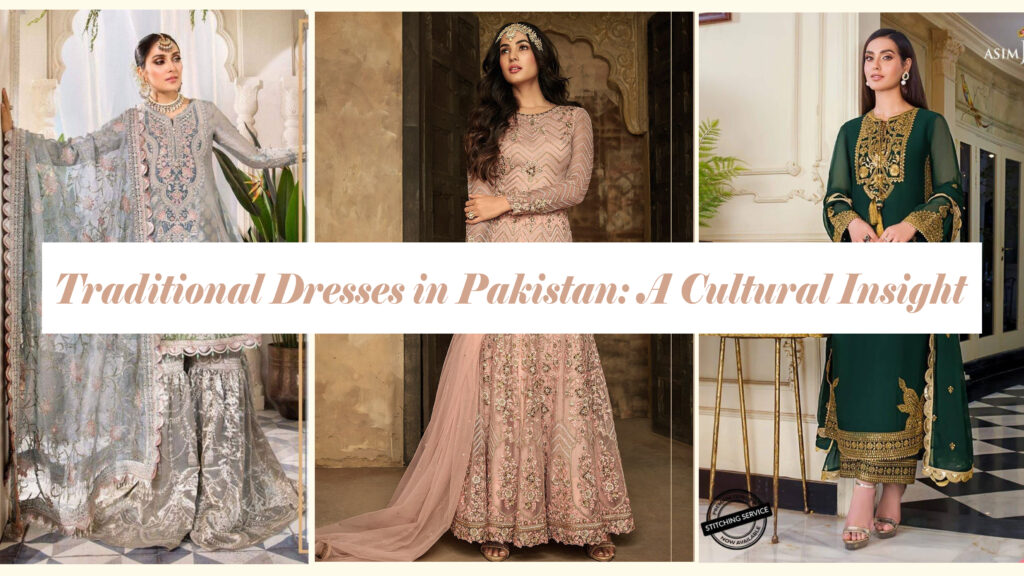Pakistan is a country rich in culture and traditions, and its traditional dresses are a reflection of this diversity. Traditional Pakistani dresses are not only visually appealing, but also have historical and cultural significance. These dresses have been influenced by the Mughal Empire, as well as the diverse regions and communities within Pakistan. Each dress style tells a story of its own, from the vibrant colors and intricate embroidery of the shalwar kameez to the delicate embellishments of the lehenga choli. Understanding the cultural significance of traditional dresses in Pakistan is an important aspect of appreciating the country’s heritage and identity. In this blog post, we will explore the historical and cultural significance of Pakistani traditional dresses, as well as their evolution over time.
The Historical Significance of Pakistani Traditional Dresses
Pakistani traditional dresses hold a great historical significance, as they reflect the cultural diversity of the country. These dresses have evolved over centuries and continue to be an integral part of the Pakistani culture. Each dress has a unique story to tell and represents a different era. These dresses also showcase the intricate craftsmanship and skills of Pakistani artisans. The design elements of these dresses have also influenced the contemporary fashion industry. The popularity of Pakistani dress design for girls has increased globally, and many fashion enthusiasts appreciate the intricate embroidery and designs of these dresses. Understanding the history behind these traditional dresses helps to preserve the culture and heritage of Pakistan. A deeper insight into the historical significance of Pakistani traditional dresses can also foster a greater appreciation for the country’s rich cultural heritage.
A Look at the Different Styles of Traditional Dresses in Pakistan
Pakistan is home to a diverse range of traditional dresses, each with its own unique style and history. From the vibrant colors and intricate embroidery of the shalwar kameez to the flowing elegance of the saree, Pakistani traditional dresses are a feast for the eyes. Other popular styles include the lehenga choli, anarkali, and gharara. These dresses not only reflect the culture and heritage of the country, but also serve as a symbol of identity and pride for many Pakistanis. Whether worn on special occasions or as everyday attire, traditional dresses continue to hold a special place in the hearts of the people. In the next section, we will explore the role of traditional dresses in celebrations and festivities.
The Role of Traditional Dresses in Celebrations and Festivities
Pakistani traditional dresses play an important role in the country’s celebrations and festivities. From weddings to Eid and other religious occasions, women adorn themselves with traditional dresses that represent their culture and heritage. These dresses vary from region to region and feature intricate embroidery, bold colors, and a mix of fabrics such as silk, chiffon, and cotton. The elaborate designs of the dresses showcase the rich history and traditions of Pakistan and add to the celebratory spirit of the events.
The Evolution of Pakistani Traditional Dresses in Modern Fashion
Pakistani traditional dresses have evolved over the years to incorporate modern fashion elements while retaining their cultural roots. Today, fashion designers in Pakistan and around the world create fusion dresses that blend traditional and contemporary styles. These modernized traditional dresses cater to the preferences of the younger generation and are popular among fashion-conscious women. The fusion dresses often feature western silhouettes combined with traditional embroidery, and they use a wider range of colors than traditional dresses. The evolution of Pakistani traditional dresses highlights the country’s ability to adapt to changing fashion trends while still embracing its cultural heritage.
Preserving Traditional Dressmaking Techniques in Pakistan
Pakistan has a rich heritage of traditional dressmaking techniques that have been passed down through generations. Unfortunately, many of these techniques are being lost due to the rise of fast fashion and globalization. However, there are still artisans and designers who are working to preserve these techniques and keep them alive. By supporting these individuals and their work, we can help to ensure that these valuable cultural practices are not lost forever. Some of these traditional techniques include hand embroidery, block printing, and weaving. These techniques are not only an important part of Pakistan’s cultural heritage, but they also provide employment opportunities for many skilled artisans. By valuing and investing in these traditions, we can help to sustain the livelihoods of these artisans and preserve Pakistan’s rich cultural heritage for generations to come.
Conclusion
In conclusion, traditional dresses in Pakistan not only reflect the country’s rich culture and history, but also play an important role in its fashion industry. These dresses are unique in their design, materials, and craftsmanship, and are valued not just for their beauty but also for their cultural significance. Despite the changes in fashion and society, traditional dressmaking techniques are still being preserved and passed on to future generations. Pakistani traditional dresses continue to inspire modern fashion and remain an integral part of the country’s identity.


